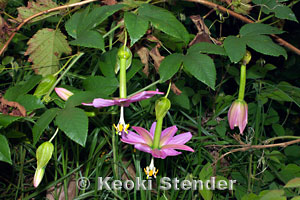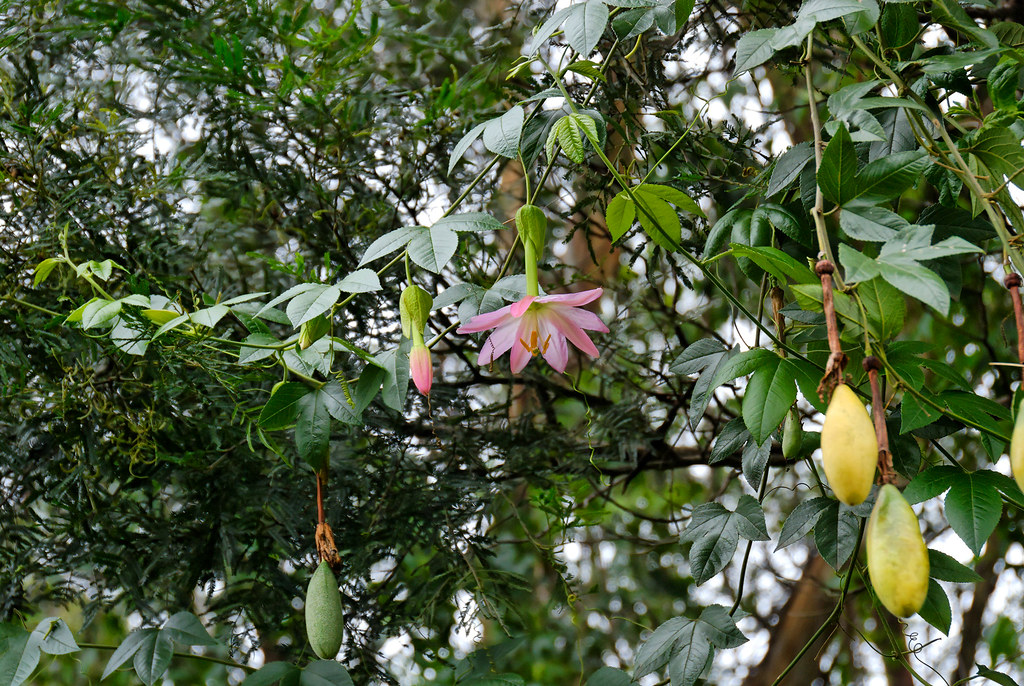Passiflora tarminiana
Passiflora tarminiana
The Passiflora tarminiana is a species of the genus of the passion vines ( Passiflora ) in the family of the passion flower plants ( Passifloraceae ). It is known only from culture and is used as a fruit. In Colombia, it is called curuba india, curuba ecuatoriana or curuba quiteña, in Ecuador as tacso amarillo, in English: called banana passionfruit, banana poka.
- 5.1 Notes and references
Description
Appearance
Passiflora tarminiana grows as an evergreen vine. The cylindrical stem axis has from 6 to 12 cm long internodes. The fibrous bark is soft with more or less fine white hair covered. There are leaf axillary, helically twisted tendrils available.
Sheet
The arranged alternate, weinlaub similar leaves are divided into petiole and leaf blade. The 1.5 to 4 cm long petiole is adaxial ( facing the shoot axis ) channel shape, fine hairs rust-colored fluffy and has one to four pairs of glands. The leaf blade is three-lobed, with a width of usually about 16 ( 7-29 ) cm. The lobes are ovate with pointed upper ends. The middle lobe is usually about 11 (5.5 to 16) cm long and usually about 5 (2.5 to 8) inches wide. The side lobes are usually about 9 ( 5 to 16 ) cm long and usually about 4 (2,3 to 7) cm wide. The leaf margin is serrated. The upper leaf surface is somewhat glossy, sparsely hairy or glabrous fluffy; the most short trichomes are mixed with some very long. The lower leaf surface is finely pubescent with rust-colored trichomes along the leaf veins. The early- sloping, geöhrten and acicular stipules has a total length of 4 to 7 mm and a width of 2 (sometimes up to 3) mm without aristate end 1-3 mm long and the awn is 3 to 4 mm long ( especially in this feature you can see the closely related species differ ).
Flower
The flowers hang singly in the leaf axils. The 3 to 10 cm long flower stalk is covered with fine hairs. The three bracts are ovate -sharpened top end, entire and grown on at least half their length with each other at a length of 3 to 4 cm and a width of 2 to 3 cm. The venation of the bracts is yellowish and the nerve network are visible. The bracts are about 1 cm from the base of the flower cup ( hypanthium ) away.
The hermaphrodite flowers are radial symmetry. The light green exterior and interior whitish corolla tube, including the hypanthium has a length of 6 to 8 cm and a diameter of 0.7 to 1 cm. The nectar chamber is significantly more than the flower tube. Nectar chamber with a diameter of 1.4 to 2 cm, nearly spherical. The curved back operculum has recurved margins. An annulus is present. The bloom is bright to light -pink; but there is also a white-flowered variety. The upright during the flowering bracts bend back during the day or the second day. The bloom is divided into slightly different from each other sepals and petals. Sepals are elongated with a length of 4.5 to 6 cm, and a width of 1.2 to 2.5 cm and the awn located below the upper end is 3-4 mm long. The petals are 3-6 mm shorter than the sepals. The aspect ratio of the corolla tube and sepals is 1.3 to 1.6. Composed of staminodes halo (corona ) is reduced to a bumpy ring at the throat of the corolla tube; He is mainly white with purple base. The five fertile stamens and style combined into a so-called column or Androgynophor. The white Androgynophor is 7 to 10 cm long. The free part of the five white stamens is about 2 cm long. The five anthers are yellow. The fluffy haired and green ovary is spindle-shaped. The three white pen each terminating in a green scar.
Fruit
Botanically speaking, it is in the fruit known as Curuba a berry. The berry is spindle-shaped with a length of 10 to 14 cm and a width of 3.5 to 4.5 cm. Young berries are soft-hairy. The pericarp is dark green with white polka dots, except along the main vascular bundles. During fruit ripening the spots disappear and the pericarp is yellow to orange - yellow. The dried pens are still visible on the fruit.
The seeds are embedded in an aril. The orange aril is sweet and aromatic. The seeds are asymmetrical, pointed, heart-shaped and reddish- brown when dry with reticulate surface.
To distinguish closely related species
Previously Passiflora tarminiana were for Passiflora mollissima var tripartita or held Passiflora mixta. The stipules are small and early fall off at Passiflora tarminiana, however, they are durable and larger in the other two species. In Passiflora tarminiana the nectar chamber is significantly more than the flower tube. Passiflora tarminiana has almost always pink but never red to wine-red bracts.
Dissemination
Passiflora tarminiana is known only from culture from tropical areas in the Andes of South America, particularly in Bolivia, Venezuela and Colombia.
In eastern Australia, New Zealand and Hawaii, Madeira and Réunion Passiflora tarminiana is an invasive plant.
System
Passiflora tarminiana was on 30 April 2001 by Geo Coppens d' Eeckenbrugge, Victoria E. Barney, Peter Møller Jørgensen, John M. MacDougal in Passiflora tarminiana, a new cultivated species of Passiflora subgenus Tacsonia ( Passifloraceae ), In: . Novon, Volume 11, pp. 8-15 first published. Passiflora tarminiana belongs to the subgenus Tacsonia the genus Passiflora.
Passiflora tarminiana together with other species of the same subgenus hybrids easily, for example, are intersections with Passiflora mollissima var tripartita and Passiflora mixta known.
Use
The aril is eaten raw or made into drinks.
From the elongated Curuba Fruit of the aril (sometimes called " flesh " ), and the seeds edible; the shell is inedible. Smell and taste are mild and surprisingly refreshing, as spicy and sour and have similarities to apple, orange and cucumber on. Ripe fruits have a uniformly yellow or red colored shell, which begins to shrink with time. Overripe fruits taste unpleasant sour.
In Europe, Curuba fruits rarely the way to the sales counters.
Swell
- Datasheet - Passiflora tarminiana Coppens & Barney, Passifloraceae at Pacific Iceland Ecosystems at Risk = PIER. (Description quoted from Coppens d' Eechenbrugge et al., 2001)
- Geo Coppens d' Eeckenbrugge, Victoria E. Barney, Peter Møller Jørgensen, John M. MacDougal Passiflora tarminiana, a New Cultivated Species of Passiflora subgenus Tacsonia ( Passifloraceae ). In: Novon. Vol 11, 2001, pp. 8-15 (first published scanned at botanicus.org ).








.jpg)

